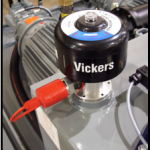How to Prevent Hydraulic Systems from Overheating
By: Brendan Casey
Insider Secrets to Hydraulics (11/03)
Why Do Hydraulic Systems Overheat?
Over-heating of hydraulic fluid in operation is caused by inefficiencies. Inefficiencies result in loss of input power, which are converted to heat. A hydraulic system’s heat load is equal to the total power lost (PL) through inefficiencies and can be expressed as:
PLtotal = PLpump + PLvalves + PLplumbing + PLactuators
If the total input power lost to heat is greater than the heat dissipated, the hydraulic system will eventually overheat.

Hydraulic Fluid Temperature – How Hot Is ‘Too Hot’?
Hydraulic fluid temperatures above 180°F (82°C) damage most seal compounds and accelerate degradation of the oil. While the operation of any hydraulic system at temperatures above 180°F should be avoided, fluid temperature is too high when viscosity falls below the optimum value for the hydraulic system’s components. This can occur well below 180°F, depending on the fluid’s viscosity grade.
Maintaining Stable Hydraulic Fluid Temperature
To achieve stable fluid temperature, a hydraulic system’s capacity to dissipate heat must exceed its inherent heat load. For example, a system with continuous input power of 100 kW and an efficiency of 80% needs to be capable of dissipating a heat load of at least 20 kW. It’s important to note that an increase in heat load or a reduction in a hydraulic system’s capacity to dissipate heat will alter the balance between heat load and dissipation.
Returning to the above example, the hydraulic power unit had a continuous power rating of 37 kW and was fitted with an air-blast heat exchanger. The exchanger was capable of dissipating 10 kW of heat under ambient conditions or 27% of available input power (10/37 x 100 = 27). This is adequate from a design perspective. The performance of all cooling circuit components were operating within design limits.
Pressure Drop Means Heat
At this point it was clear that the overheating problem was being caused by excessive heat load. Concerned about the length of the umbilical, I calculated its pressure drop. The theoretical pressure drop across 710 feet of ¾” pressure hose at 24 gpm is 800 psi. The pressure drop across the same length of 1″ return hose is 200 psi. The formula for these calculations is available here. The theoretical heat load produced by the pressure drop across the umbilical of 1,000 psi (800 + 200 = 1000) was 10.35 kW. The formula for this calculation is available here.
This meant that the heat load of the umbilical was 0.35 kW more than the heat dissipation capacity of the hydraulic system’s heat exchanger. This, when combined with the system’s normal heat load (inefficiencies) was causing the hydraulic system to overheat.
Beat The Heat
There are two ways to solve overheating problems in hydraulic systems:
1. Decrease heat load
OR
2. Increase heat dissipation.
Decreasing heat load is always the preferred option because it increases the efficiency of the hydraulic system. In the above example, the heat load of the umbilical alone was nearly 30% of available input power, a figure that would normally be considered unacceptable. Decreasing this heat load to an acceptable level would have involved reducing the pressure drop, by replacing the pressure and return lines in the umbilical with larger diameter hoses. The cost of doing this for what was a temporary installation meant that, in this case, the most economical solution was to install additional cooling capacity in the circuit.
Continuing to operate a hydraulic system when the fluid is over-temperature is similar to operating an internal combustion engine with high coolant temperature. Damage is guaranteed. Therefore, whenever a hydraulic system starts to overheat, shut it down, identify the cause and fix it.
More from my site
One Response to How to Prevent Hydraulic Systems from Overheating
Leave a Reply
-
Archives
- August 2022
- April 2022
- August 2021
- December 2020
- August 2020
- January 2019
- September 2018
- March 2018
- February 2018
- December 2017
- November 2017
- October 2017
- September 2017
- May 2017
- April 2017
- March 2017
- February 2017
- October 2016
- September 2016
- August 2016
- July 2016
- June 2016
- March 2016
- September 2013
- July 2013
- March 2013
- January 2013
- December 2012
- November 2012
- October 2012
- September 2012
- August 2012
- July 2012
- June 2012
- May 2012
- April 2012
- March 2012
- February 2012
Signup Today
to get our monthly Enews delivered to your inbox.








